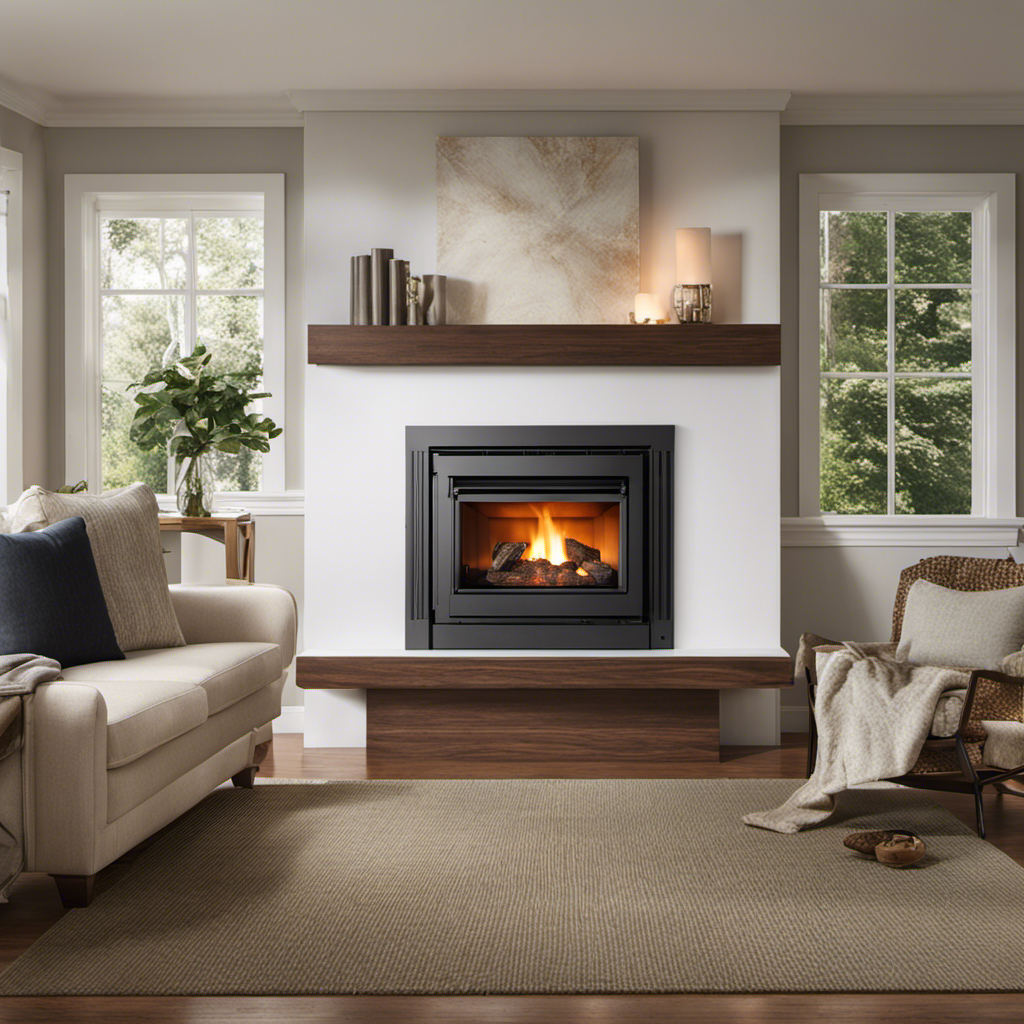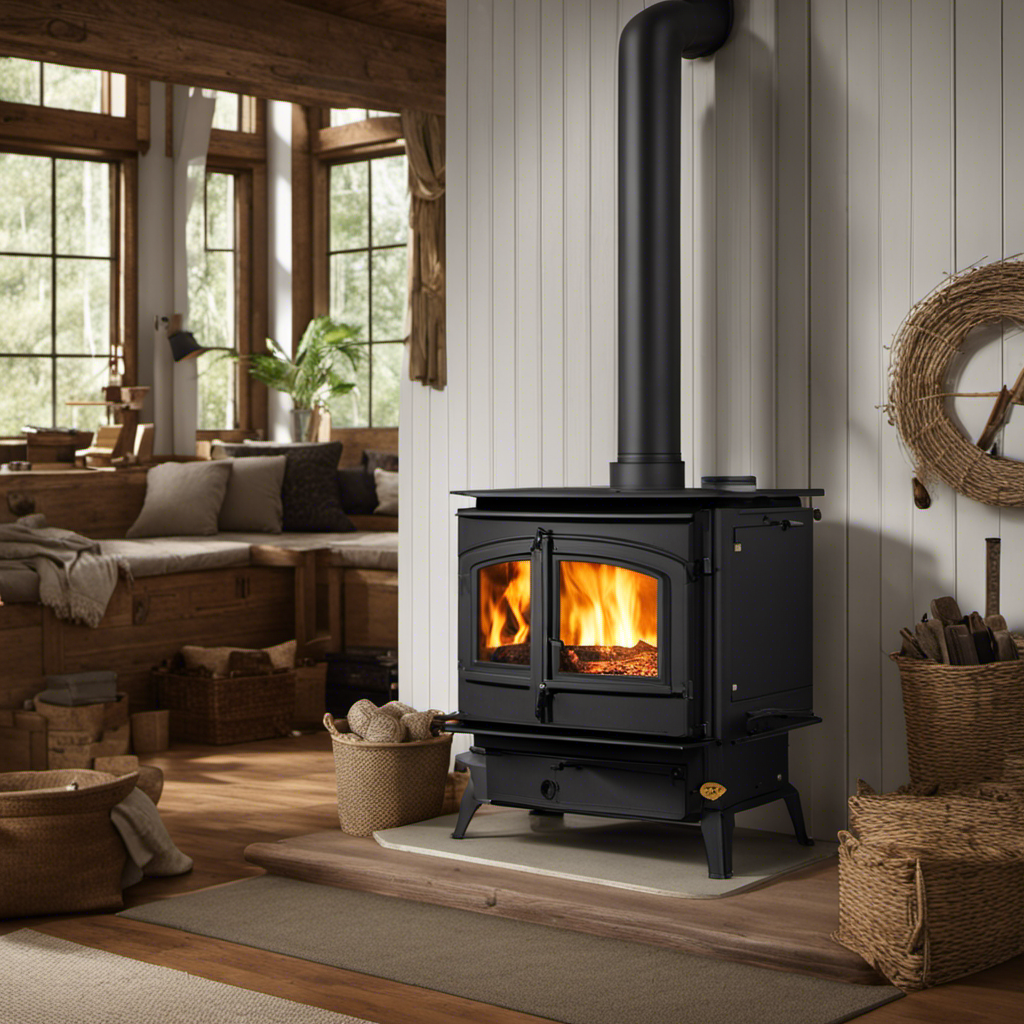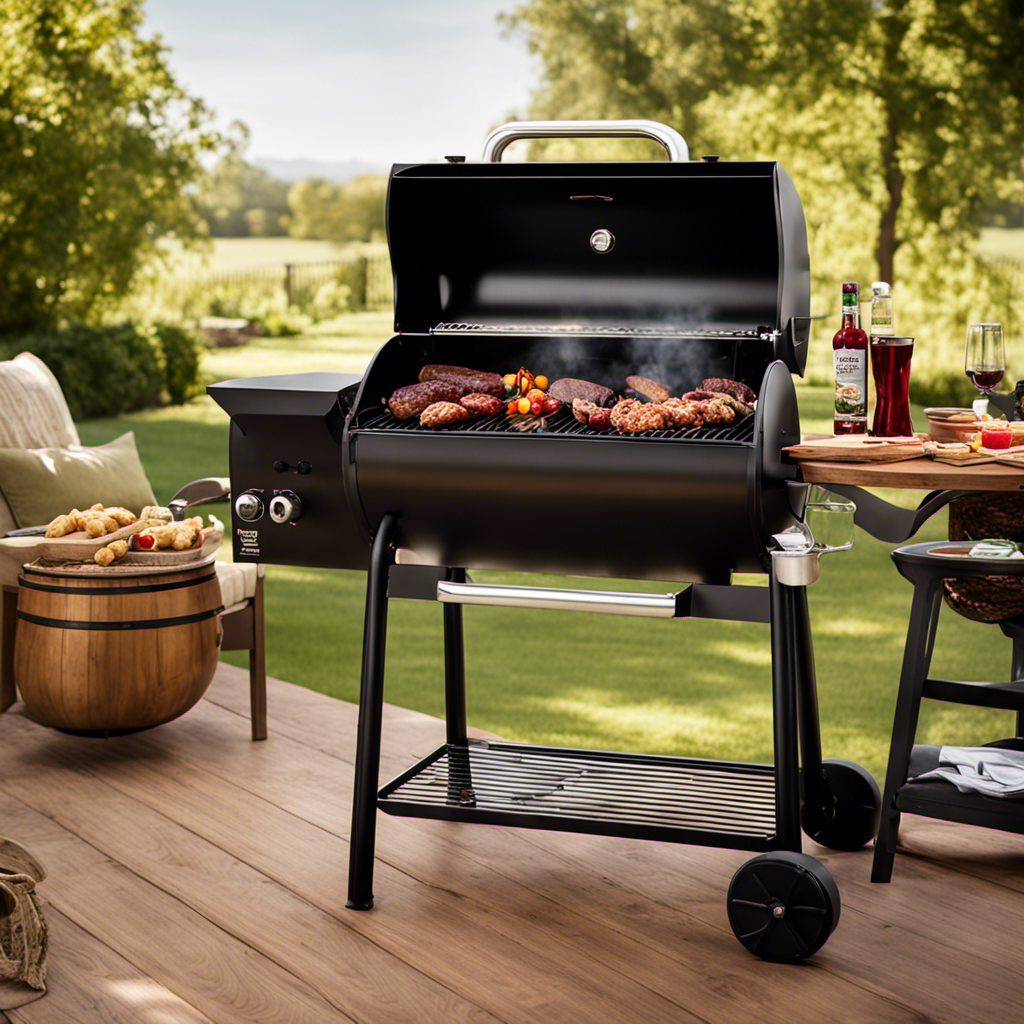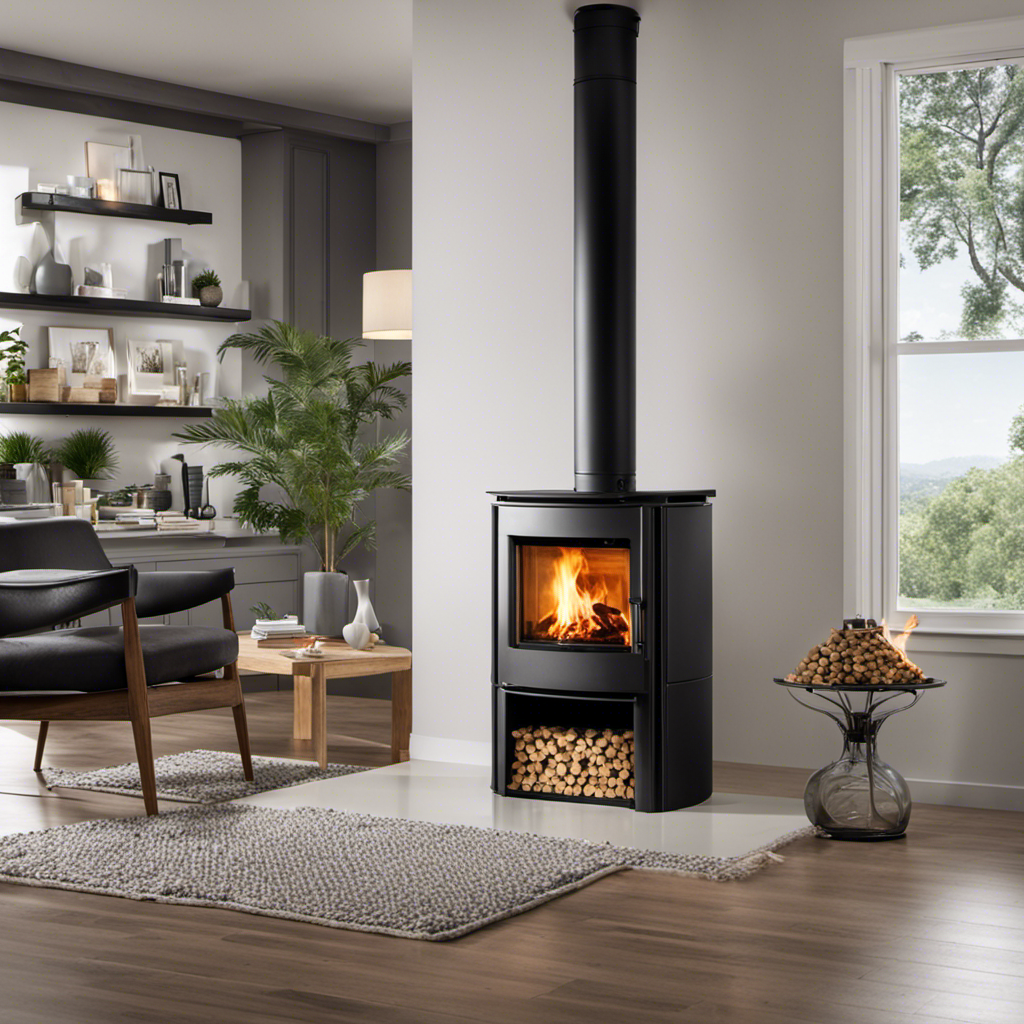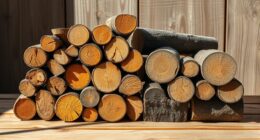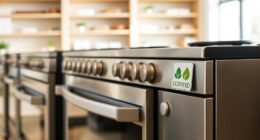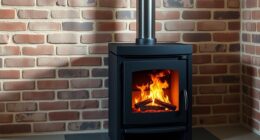You could have been operating your wood-burning fireplace for a considerable period, and at this point, you desire an enhancement. Picture the ease of basking in the cozy warmth of a fire without the inconvenience of chopping and storing firewood.
Well, converting your wood fireplace to a pellet stove can make that dream a reality. In this article, I’ll guide you through the step-by-step process of transforming your fireplace into a convenient and efficient pellet stove.
Let’s get started!
Key Takeaways
- Assess chimney and fireplace dimensions to determine suitability for pellet stove installation
- Ensure proper ventilation and clearance requirements for safe and efficient operation
- Gather necessary tools and materials for a smooth conversion from wood fireplace to pellet stove
- Follow safety considerations and local regulations to prevent hazards and maintain a safe environment
Assessing Your Wood Fireplace
Before you can convert your wood fireplace to a pellet stove, you’ll need to assess its condition and functionality. Start by examining the chimney. Make sure it is in good condition and free from any cracks or blockages. A damaged chimney could pose a safety risk and may require repair before installing a pellet stove.
Next, evaluate the space requirements for the pellet stove. Measure the dimensions of your fireplace to ensure it can accommodate the new appliance. Consider the clearance requirements specified by the manufacturer to ensure proper ventilation. Additionally, check if the hearth is strong enough to support the weight of the pellet stove.
Once you have assessed these factors, you can move on to choosing the right pellet stove that suits your needs and preferences.
Choosing the Right Pellet Stove
When it comes to choosing the right pellet stove, there are several key points to consider.
First, the efficiency of pellet stoves is an important factor to evaluate. Pellet stoves are known for their high efficiency, with some models boasting efficiency ratings of over 90%.
Second, the cost of pellet fuel is another crucial consideration. While the initial investment in a pellet stove may be higher compared to other heating options, the cost of pellet fuel is generally lower than traditional fuels like oil or propane.
Lastly, it is essential to take into account the installation considerations for pellet stoves. These stoves require proper venting and may need a dedicated electrical circuit, so it is crucial to consult with a professional installer to ensure a safe and efficient installation.
Efficiency of Pellet Stoves
The efficiency of pellet stoves can be improved by using a thermostat. Unlike traditional fireplaces, which lose a significant amount of heat up the chimney, pellet stoves are designed to maximize heat output. The use of a thermostat allows for precise temperature control, ensuring that the stove operates at its most efficient level.
This means that the stove will only burn pellets as needed to maintain the desired temperature, conserving fuel and reducing energy waste. The benefits of pellet stoves in heating homes are numerous. They are more efficient than traditional fireplaces, provide consistent heat, and are environmentally friendly.
Cost of Pellet Fuel
Using a thermostat with a pellet stove can help homeowners save money on fuel costs. Pellet fuel is a cost-effective alternative to traditional heating options, such as oil or gas. Not only is it more affordable, but it also burns efficiently, producing more heat for the same amount of fuel.
Additionally, pellet stoves require regular maintenance to ensure optimal performance and longevity. This includes cleaning the stove and chimney, inspecting and replacing parts as needed, and scheduling professional servicing. By properly maintaining your pellet stove, you can prevent potential issues and maximize its efficiency.
When considering alternative heating options, pellet stoves offer a great balance between cost-effectiveness and environmental friendliness.
Now, let’s discuss the installation considerations for pellet stoves without delay.
Installation Considerations for Pellet Stoves
One important consideration when installing a pellet stove is ensuring proper ventilation for the unit to function safely and efficiently. Here are some installation tips and maintenance guidelines to help you get started:
-
Ventilation: Ensure that your pellet stove has a dedicated venting system that meets local building codes. This will help remove the exhaust gases and prevent any potential hazards.
-
Clearances: Maintain proper clearances around the pellet stove to avoid any fire hazards. Follow the manufacturer’s guidelines for minimum clearance requirements to nearby combustible materials.
-
Regular Cleaning: Regularly clean the ash pan, burn pot, and the chimney to ensure optimal performance. This will prevent the build-up of ash and increase the efficiency of your pellet stove.
Now that you understand the importance of proper ventilation and maintenance, let’s move on to gathering the necessary tools and materials for the installation process.
Gathering the Necessary Tools and Materials
When it comes to gathering the necessary tools and materials for converting a wood fireplace to a pellet stove, it’s important to be well-equipped.
Some of the required tools include a reciprocating saw, a drill, a screwdriver, and a level.
As for the materials, you’ll need a pellet stove insert, a chimney liner, and various connectors and fittings.
It’s crucial to have all the necessary tools and materials on hand before starting the conversion process to ensure a smooth and successful installation.
Required Tools and Materials
To convert your wood fireplace to a pellet stove, you’ll need a set of specific tools and materials. Here are the three essential items you’ll need for the installation process:
-
Pellet Stove: The first and most important item you’ll need is a pellet stove. Consider the size and heating capacity that meets your needs, and research different brands and models to find the best one for you.
-
Chimney Liner: Installing a chimney liner is crucial for proper venting and safety. This stainless steel liner will ensure the efficient removal of combustion gases from your pellet stove.
-
Pellet Vent Kit: A pellet vent kit includes all the necessary components for venting your pellet stove, including pipes, elbows, and termination caps. Make sure to choose the right size and type of venting system for your specific installation.
Cost and Availability
If you’re considering switching to a pellet stove, it’s important to consider the cost and availability of these alternative heating options. A cost analysis is crucial to determine whether investing in a pellet stove is worth it in the long run. When comparing options, it’s essential to factor in the initial purchase cost, installation expenses, and ongoing maintenance fees.
Additionally, you need to consider the availability of pellets in your area. Are they readily accessible and affordable? It’s worth researching local suppliers and comparing prices to ensure a steady supply of fuel without breaking the bank.
By conducting a thorough cost analysis and comparing options, you can make an informed decision about whether a pellet stove is the right choice for you.
Now, let’s move on to the safety considerations when converting your wood fireplace.
Safety Considerations
When considering the conversion of a wood fireplace to a pellet stove, it’s crucial to take safety into consideration. Ventilation is a key aspect of fireplace safety, and it’s important to ensure that your pellet stove is properly vented to prevent the buildup of harmful gases. Here are three safety considerations to keep in mind:
-
Ventilation Requirements: Check your local safety regulations to determine the specific ventilation requirements for pellet stoves. This typically involves installing a vent pipe that extends from the stove to the outside of your home.
-
Carbon Monoxide Detection: Pellet stoves, like any other fuel-burning appliance, produce carbon monoxide. Install carbon monoxide detectors near the stove and throughout your home to ensure early detection of any potential leaks.
-
Clearances and Fireproofing: Maintain proper clearances around your pellet stove to prevent any flammable materials from coming into contact with the stove. Additionally, consider installing a fireproof barrier around the stove to further enhance safety.
With these safety considerations in mind, let’s now move on to preparing your fireplace for conversion.
Preparing Your Fireplace for Conversion
First, you’ll want to clean out any debris or ash from your wood fireplace before starting the conversion process. Evaluating options is an important step when converting your wood fireplace to a pellet stove.
There are different types of pellet stove inserts available, so it’s crucial to choose one that suits your needs and fits your fireplace dimensions. Once you have selected the right pellet stove insert, you will need to remove the existing fireplace grate and clean the firebox thoroughly.
Next, you’ll need to install the adapter or venting system to connect the pellet stove insert to your chimney. This transition ensures proper ventilation and safety. With the fireplace prepared for conversion, you can now move on to installing the pellet stove insert, which we will discuss in the next section.
Installing the Pellet Stove Insert
Once you’ve selected the right pellet stove insert and cleaned the firebox, it’s time to install it.
Installing a pellet stove comes with various benefits, such as energy efficiency, cost savings, and environmental friendliness.
Here are three key steps to successfully install a pellet stove insert:
-
Positioning the stove: Carefully place the stove in the desired location, ensuring it meets the required clearances from combustible materials. Follow the manufacturer’s instructions for proper placement and use a non-combustible hearth pad if necessary.
-
Venting the stove: Connect the stove to the venting system, which should include a chimney liner or a direct vent pipe. Proper venting ensures the safe expulsion of combustion byproducts and efficient operation of the stove.
-
Electrical connection: Plug the stove into a nearby electrical outlet or have a dedicated circuit installed if needed. Ensure the electrical supply meets the stove’s requirements and use a surge protector for added safety.
With the pellet stove insert installed, the next step is to connect it to the chimney for proper ventilation.
Connecting the Pellet Stove to the Chimney
To ensure proper ventilation, it’s important to connect the pellet stove insert to the chimney. This step is crucial in the installation process of a pellet stove.
By connecting the stove to the chimney, you create a pathway for the exhaust gases to safely exit your home. The process begins by attaching the flue collar on the back of the stove to the chimney pipe. It’s essential to ensure a tight and secure connection to prevent any leaks.
Depending on your setup, you may need to install a chimney liner to improve the efficiency and safety of your pellet stove. Once the connection is made, it’s advisable to inspect the chimney for any damages or obstructions. This will guarantee a smooth and effective operation of your pellet stove.
Now, let’s move on to setting up the pellet storage and delivery system.
Setting Up the Pellet Storage and Delivery System
Now that the pellet stove is properly connected to the chimney, it’s time to set up the pellet storage and delivery system. This is an important step in ensuring that the pellet stove operates efficiently and effectively. Here are three key considerations for setting up the pellet storage and delivery system:
-
Pellet Storage Options: There are different options available for storing pellets, including bags, bins, and hoppers. Bags are the most common and can be easily stored in a dry area. Bins provide a larger storage capacity and are usually placed near the pellet stove. Hoppers are integrated into the pellet stove itself and automatically feed pellets into the burn chamber.
-
Pellet Delivery Methods: Pellets can be delivered to the pellet stove manually or through an automated system. Manual delivery involves filling the hopper or bin with pellets as needed. Automated delivery systems use augers or vacuum systems to transport pellets from the storage area to the burn chamber.
-
Maintenance and Cleaning: Regardless of the storage and delivery method chosen, regular maintenance and cleaning of the system is essential. This includes inspecting and cleaning the storage area, checking for any blockages or obstructions in the delivery system, and ensuring proper airflow to the burn chamber.
With the pellet storage and delivery system in place, it’s time to move on to the next step: testing and adjusting the pellet stove for optimal performance.
Testing and Adjusting the Pellet Stove
After setting up the pellet storage and delivery system, it’s important to test and adjust the stove for optimal performance. This step ensures that the pellet stove is functioning efficiently and effectively. Adjusting pellet settings may be necessary to achieve the desired heat output and fuel consumption. To do this, refer to the manufacturer’s instructions and make small adjustments at a time, monitoring the stove’s performance after each change. Troubleshooting the pellet stove is also crucial to identify and fix any issues that may arise. Common problems include a lack of ignition, inconsistent flame, or excessive smoke. Consult the troubleshooting guide provided by the manufacturer or seek professional assistance if needed. By properly adjusting and troubleshooting your pellet stove, you can ensure its longevity and efficient operation.
| Common Issues | Possible Solutions |
|---|---|
| Lack of ignition | Check for fuel supply, clean the igniter, or replace if necessary |
| Inconsistent flame | Adjust air intake or clean the burner |
| Excessive smoke | Clean the flue, adjust air settings, or check for blockages |
In the subsequent section about maintaining and troubleshooting your pellet stove, we will explore additional steps to keep your stove in optimal condition.
Maintaining and Troubleshooting Your Pellet Stove
Make sure you regularly clean the flue and check for any blockages to ensure your pellet stove operates smoothly and efficiently.
Here are some maintaining tips and troubleshooting techniques to keep your pellet stove in top shape:
-
Clean the ash regularly: As pellets burn, they produce ash that can accumulate inside the stove. Regularly cleaning the ash helps maintain proper airflow and prevents clogging.
-
Check the hopper: Ensure that the hopper is properly filled with pellets. A low pellet level can cause the stove to malfunction or not ignite at all.
-
Inspect the exhaust system: Check the exhaust system for any leaks or damage. A faulty exhaust system can affect the stove’s performance and efficiency.
Frequently Asked Questions
How Much Does It Cost to Convert a Wood Fireplace to a Pellet Stove?
Converting a wood fireplace to a pellet stove can be a cost-effective choice. Pellet stoves offer numerous benefits such as increased efficiency, lower fuel costs, and reduced emissions. The exact cost will vary depending on factors like the size of your fireplace and the type of pellet stove you choose.
Can I Use My Existing Chimney for a Pellet Stove?
Yes, you can use your existing chimney for a pellet stove. However, some modifications may be needed to ensure proper venting and airflow. It’s important to consult with a professional to ensure a safe and efficient installation.
How Long Does It Take to Install a Pellet Stove Insert?
On average, the installation of a pellet stove insert takes about 4-6 hours. However, this time can vary depending on the complexity of the job and any challenges encountered during the process.
Do I Need to Hire a Professional to Install a Pellet Stove?
Hiring a professional for a pellet stove installation has its pros and cons. DIY installation can be cost-effective, but preparation is key. Research the necessary steps and ensure you have the skills and tools required.
Can a Pellet Stove Be Used as the Primary Heat Source for a Home?
Using a pellet stove as the primary heat source has pros and cons. Factors to consider when choosing between a pellet stove and a wood fireplace include efficiency, cost, and environmental impact.
Conclusion
In conclusion, converting a wood fireplace to a pellet stove is a great way to improve the efficiency and convenience of heating your home.
With the right tools and materials, this process can be done successfully.
One interesting statistic to consider is that pellet stoves can be up to 85% efficient, compared to wood fireplaces that typically have an efficiency rating of only 10-30%.
This means that by converting to a pellet stove, you can significantly reduce your heating costs and have a more environmentally friendly heating option.
Logan’s affair with adventure began in childhood. He hailed from a small town where vast forests bordered one side and endless shores stretched on the other. His days were spent exploring uncharted woods, climbing tall trees, or listening to the tales of old sailors. This early immersion in a world brimming with stories and mysteries became the foundation of his passion for writing.

